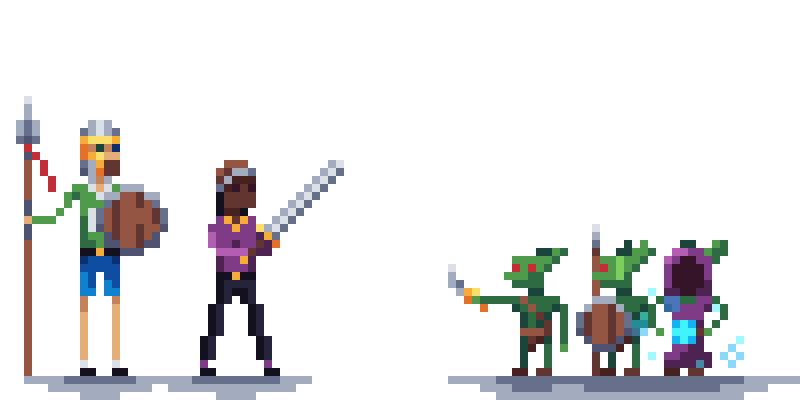Kampf/en: Unterschied zwischen den Versionen
(Übernehme Bearbeitung einer neuen Version der Quellseite) |
|||
| (Eine dazwischenliegende Version desselben Benutzers wird nicht angezeigt) | |||
| Zeile 1: | Zeile 1: | ||
<noinclude> | <noinclude> | ||
<languages /> | <languages /> | ||
[[Datei:how_to_kampf | [[Datei:how_to_kampf-en.png|rechts|350px|How to Battle]] | ||
{{Offiziell{{#translation:}}}}</noinclude> | {{Offiziell{{#translation:}}}}</noinclude> | ||
==General== | ==General== | ||
Aktuelle Version vom 13. April 2021, 22:28 Uhr
General
In general, a fight represents a special situation. In "free play" multiple actions can take place sequentially or simultaneously. In combat, though the actions are performed one after another, but in game these actions happen almost simultaneously. A round of combat takes 3 to 8 seconds in the game (depending on the number of combatants and the situation).
A combat situation is divided into the following areas:
- Initiative
- Ambush
- Combat (turn based)
- End
1. Initiative
The initiative represents how quickly a character reacts within the combat situation. The higher the roll, the sooner the character's turn.
Each player rolls 1d10 and adds their physical points to the results. The gamemaster can either roll a separate initiative roll for each NPC or, if all NPCs have the same physical points, a collective initiative roll.
| Howky and Bernd face a group of three snarling goblins with razor-sharp teeth.
Diplomacy has failed. Now your weapons have to do the talking |
The gamemaster lets Howky and Bernd roll for initiative.
15.
19. |
| The gamemaster determines that Bernd goes first. Then it is the goblins turn, and finally Howky may perform his action. |
2. Ambush
If a fighter has not noticed his opponents initially, yet they are aware of him, he is caught in surprise. If a combatant is surprised, he cannot participate in the first round of the fight / combat. (The gamemaster can make the players roll for perception or a similar skill beforehand, in order to detect an ambush for example. If this succeeds, the characters are not surprised).
| Howky and Bernd venture deep into a cave and run directly into the trap of a well-positioned Orc Archer.
The gamemaster decides that this is a combat situation and lets all participants roll for initiative. The gamemaster decides that Howky, due to his skill "perception", has a chance to escape the surprise. SUCCESS! As Howky and Bernd advance further into the cave, Howky hears the drawing of a bowstring and gets ready to fight, while an orcish arrow lands right next to the stunned Bernd. |
3. Combat (turn based)
In combat, all characters perform their actions in order, starting with the character with the highest initiative value. This value must be re-rolled for each battle.
Attack
The player rolls for attack according to his character's corresponding ability. If it succeeds, the character strikes his opponent and can inflict damage.
Defense/ Parry
Once per turn, a character can attempt to parry an attack. A parry roll is a roll for action. If the character has a shield or weapon that can be used to parry particularly well or poorly, the gamemaster can add an appropriate (dis-)advantage to the roll. If the roll succeeds, the attack is fended off and the character does not suffer any damage. Critical attacks cannot be parried. If the character parries an armed attack with his bare fists, the character takes half the damage (rounded).
Firearms cannot be parried.
Damage
The amount of damage inflicted depends on the weapon used. The damage is rolled with xd10, where x varies from weapon to weapon (see Weapon types / damage below). . If the character's health drops to 0, the character dies immediately. If a player gets a critical hit with his weapon (see [[Würfe & Proben (kritische Erfolge & Fehlschläge){{#translation}}|Throws & Tests]]), the damage is doubled.
Example: Normal damage: 3d10 damage. Total = 19 Critical damage: 3d10 x2 damage. Total = 19 x 2 = 38 damage
4. End
A combat situation is considered over when all characters or enemies are out of health, or the enemies/characters have escaped and are out of range. Of course, it is also possible that a party surrenders. At that point they are at the mercy of the other party. In this case the gamemaster or the player's mercy decides when the fight is over.
Weapon types/damage
Weapons can vary from scenario to scenario. In a medieval world you fight mainly with swords, axes, and bows, while in a futuristic world laser guns or similar things are used. The damage a weapon can deal therefore varies greatly. Basically, each weapon causes damage equal to a certain number of 10-sided dice. The following table is a guideline and is intended as a tool for the gamemaster to design his own weapons. Of course an axe, for example, can also cause more damage than a sword.
| mprovised weapons (tools/boards)/unarmed combat | 1d10 damage |
| Stick | 1W10 + 5 damage |
| Knife/Dagger | 2W10 damage |
| Slingshot/Throwing weapons | 3W10 damage |
| Axe/Mace/War hammer/Baseball bat | 4W10 damage |
| Sword/Machete | 5W10 damage |
| Bow/Crossbow | 6W10 damage |
| Pistols | 7W10 damage |
| Guns | 8W10 damage |
| Shotgun | 9W10 damage(damage decreases with increasing distance) |
| Bomb/Grenade/Mine/Rocket Launcher | 10W10 damage |
The damage of the weapons can be increased by the gamemaster with bonuses. For instance, if it is a special weapon (i.e. masterfully crafted or legendary weapons), the gamemaster can grant a permanent buff. The sword Excalibur, for example, could have a damage value of 5d10 + 10.
In the same way, the damage dealt by "weaponless combat" can be adjusted by the gamemaster for especially strong characters. A boxer or martial arts fighter can cause significantly more d10 + x damage than other characters.


